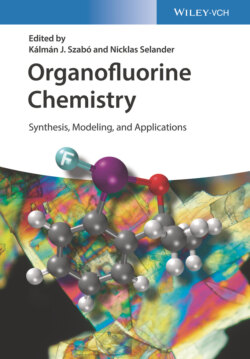Читать книгу Organofluorine Chemistry - Группа авторов - Страница 35
2.3.2 Photocatalytic Reactions Using Perfluorocarboxylic Anhydride/Pyridine N‐oxide
ОглавлениеStephenson applied photochemistry to perfluoroalkylation using perfluorocarboxylic anhydrides (Scheme 2.36) [68], in which the perfluorocarboxylic anhydride‐pyridine N‐oxide adduct is generated in situ as a reactive intermediate [69]. The reaction was applicable to a diverse array of substrates, such as vinyl, aryl, and heteroaryl compounds, and could be run on a kilogram scale by the use of a flow system. Their conditions are also available for chlorodifluoromethylation of aromatic compounds with chlorodifluoroacetic anhydride. In addition, the reaction of alkyne was found to give gem‐difluoroenones via oxy‐chlorodifluoromethylation and subsequent elimination of chloride (Scheme 2.37).
Scheme 2.36 Photocatalytic reaction using anhydrides/pyridine N‐oxides. a. With pyridine N‐oxide, b. With 4‐Ph‐pyrdine N‐oxide, c. Stirred with MeOH on reaction completion, d. Stirred with DBU on reaction completion.
Schaub and coworkers very recently reported a photocatalytic α‐trifluoromethylation of aromatic ketones by using trifluoroacetic anhydride/pyridine N‐oxide (Scheme 2.38) [70].
The reaction proceeds via oxy‐trifluoromethylation, which installs a CF3 group and trifluoroacetate on in situ‐formed vinyl trifluoroacetate; the resulting trifluoroacetyl‐protected acetal was transformed upon workup to the trifluoromethylated ketone product.
Scheme 2.37 gem‐Difluoroenone synthesis by chlorodifluoromethylation of alkynes.
Scheme 2.38 Photocatalytic α‐trifluoromethylation of aromatic ketones.
